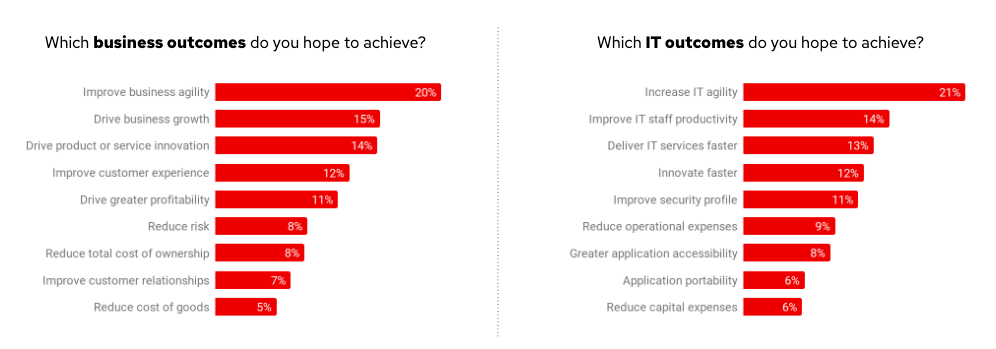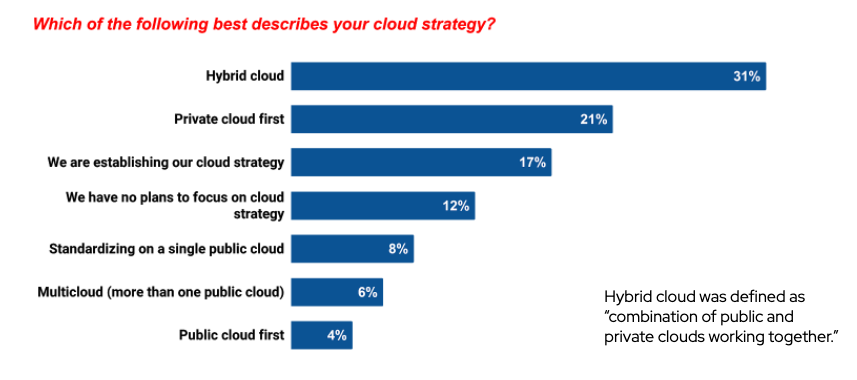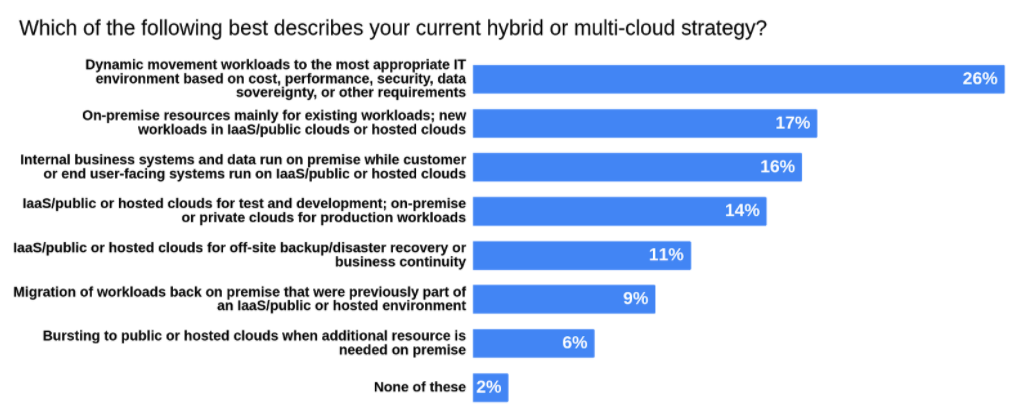红帽博客
Our interactions with businesses can happen in person, on the web, on our mobile devices, in marketplaces or via APIs. To enable these interactions, IT organizations are increasingly being driven towards hybrid IT architectures involving private cloud, public cloud, edge computing, AI/ML and more to provide multiple different routes to the customer.
This mixed use of public and private clouds, possibly with some degree of workload portability, integration, orchestration, and unified management across those clouds is often referred to as hybrid cloud computing. Research shows that improving business agility and increasing IT agility are key drivers for organizations that are implementing a hybrid cloud strategy.

Source: Global hybrid cloud survey. Conducted by Red Hat via Qualtrics, September-October 2019.
And we are seeing that hybrid cloud, and multicloud, adoption is increasing and forecast to continue to increase. Multicloud is when IT organizations use multiple clouds from multiple private or public providers, for multiple workloads or tasks, without interconnectivity between clouds.

Source: 2020 Red Hat Global Customer Tech Outlook survey. Conducted by Red Hat via Qualtrics, August-September 2019
In addition, hybrid cloud is seen as the leading strategy for organizations surveyed for the Global Customer Tech Outlook going forward.

Source: 2020 Red Hat Global Customer Tech Outlook survey. Conducted by Red Hat via Qualtrics, August-September 2019
The Qualtrics survey from last fall shows that the primary motivator for hybrid cloud adoption is the ability to dynamically move workloads to the most appropriate IT environment based on cost, performance, security, data sovereignty or other requirements.

Source: Global hybrid cloud survey. Conducted by Red Hat via Qualtrics, September-October 2019.
We conducted these surveys last year before the current crisis hit. However, in talking with customers and prominent analyst firms, we are finding that organizations like the ones surveyed still moving forward with their hybrid and multicloud strategies, and some are even accelerating these efforts.
Workloads are critical. The key aspect of any hybrid cloud architecture or design is to make sure that it supports an “application-first” strategy.
Applications are key to business and IT success and making sure that applications are performant, secure, accessible, and scalable is foundational to any infrastructure architecture. Understanding application requirements around integration, access management, network latency, security, compliance, licensing, CPU and memory consumption, and business continuity are critical in a hybrid cloud infrastructure design.
If you are considering a hybrid cloud strategy or are already embarking on your hybrid cloud journey, there are some additional key factors that you should consider.
Amazon Web Services and Red Hat have come together to help you understand these factors so that you can make the best hybrid cloud architecture choices for your situation. You should put some careful thought into and ask hard questions about the following aspects of your hybrid cloud design:
-
Application deployment, operations and management
-
Infrastructure management and control
-
Operating system foundation
-
Security and compliance
-
Cloud services utilization, deployment and management
-
Data management and storage
For more detailed information on these key considerations for your hybrid cloud journey, check out this Hybrid Cloud Checklist from Red Hat and Amazon Web Services and watch this informative webinar in which Red Hat and AWS discuss the nuances of developing a hybrid cloud strategy.
About the author
Dan Juengst is Sr. Principal Technology Evangelist at Red Hat. He has 20+ years of high tech experience in areas such as DevOps, cloud computing, Platform as a Service, application performance, grid computing, and high performance computing. Juengst has held senior technical positions at CloudBees, CA Technologies, Sun Microsystems, SGI, and Wily Technology. His roots in technology originated in the Aerospace industry where he leveraged high performance compute grids to design rockets.

